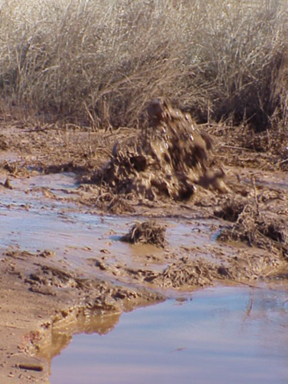
Geotimes Home | AGI Home | Information Services | Geoscience Education | Public Policy | Programs | Publications | Careers

 Gassy
eruption in Oklahoma
Gassy
eruption in Oklahoma
On Friday, Dec. 9, hunters wandering through rural Kingfisher County in central
Oklahoma noticed something odd. What was normally a peaceful flowing brook had
become a raging torrent of bubbling mud and water.
Winter Camp Creek, normally about 3 meters (10 feet) wide, had suddenly burst
9 meters out of its banks, sending plumes of mud and water flying 6 meters high.
A 12-meter-high geyser erupted in the middle of a field nearby, and smaller
explosions broke up a couple of nearby roads. Over the following days and weeks,
officials worked to control the situation, and several groups are still investigating
just how the geyser formed.
In December, a normally peaceful creek
in rural Oklahoma became a raging torrent of mud, gas and water, when gas escaped
from a blowout at a nearby natural gas reservoir. Photo is courtesy of Matt
Skinner.
“It looked like a hot tub run amuck,” says Matt Skinner, a spokesman
for the Oklahoma Corporation Commission, a state regulatory agency. “The
water was roiling in the worst rapids you’ve ever seen, and occasionally
erupting upwards.”
Although officials determined that there was no immediate danger within 24 hours
of the first report of the roiling waters, all the agencies involved “immediately
flew into emergency management mode,” Skinner says, worried that it could
be “another Hutchinson” — a town in Kansas where natural gas
explosions killed two people in 2001 (see Geotimes,
October 2001). Fortunately, however, no one was injured and at this point,
there do not seem to be any lasting environmental consequences, he says.
In the end, an area covering about 14 to 17 kilometers was affected by what
turned out to be a gas blowout from a nearby natural gas reservoir. “Although
we can’t say with 100 percent certainty what happened,” the data indicate
that the gas eruptions occurred soon after Chesapeake Energy Corporation experienced
problems at a drilling site, when it struck a massive gas field “the likes
of which no one thought still existed in that area,” about 8 kilometers
from where the geysers eventually occurred, Skinner says.
Figuring out what was happening — and how to stop the activity, especially
before the gas leak reached a populated area just a kilometer or so downstream
— took a major detective effort, Skinner says. Over a short time period,
the commission, with assistance from the Oklahoma Geological Survey and Duke
Energy, had a lot of work to do.
After ruling out a broken pipeline as the culprit, officials examined several
other possible causes — including earthquakes, blowouts of wells that had
been plugged, and the possibility that there were old, unused underground gas
storage facilities in the area — but all led to dead ends. The only other
option was that the eruption had something to do with the reservoir that Chesapeake
Energy had just found.
After sampling the gas erupting out of the creek, officials pinpointed its production
zone. They then walked the length of the creek, as well as through the roads
and field where the gas was escaping, and mapped every point at which they saw
bubbles or geysers.
Sure enough, Skinner says, the data pointed back to Chesapeake’s reservoir.
At the request of the commission, four days after the disturbance was discovered,
Chesapeake began producing the well to relieve the pressure and plug the wells.
The entire process took about two weeks.
Over the years, the Oklahoma Geological Survey has been investigating several
similar, albeit smaller, events, says Charles Mankin, director of the survey.
“We’re trying to understand how gas is getting from deep horizons
to shallow horizons miles away from the source.” The gas cannot be migrating
through simple faults or fractures, he says, because the distribution pattern
is not correct: It is following some well-confined conduit.
Mankin suspects that the pathways may be cavernous subsurface pockets created
by the dissolution of evaporite deposits. If that is the case, then “perhaps
we can map them and get a handle on this” to prevent further gas eruptions,
he says.
In the aftermath of the Kingfisher event, Mankin is leading a seismic survey
to “delineate the subsurface pathways, assuming they exist, in all of western
Oklahoma,” he says, so that companies can avoid drilling in potentially
hazardous spots. Conducting a survey is in the industry’s best interest,
he notes, as companies want to avoid blowouts, and the loss of gas and other
problems associated with such events.
Tom Price, a spokesman for Chesapeake Energy, says that the company is not commenting
on the size of the reservoir or how much gas — or money — the company
has lost since this situation began in December. But Mankin speculates that
millions if not billions of cubic feet of gas have been lost, and with natural
gas prices as high as they are currently, total costs are likely in the millions.
Megan Sever
Link:
"Hutchinson,
Kansas: A Geologic Detective Story," Geotimes, October 2001
 |
Geotimes Home | AGI Home | Information Services | Geoscience Education | Public Policy | Programs | Publications | Careers |